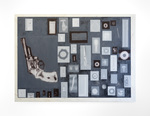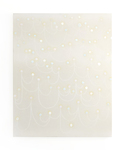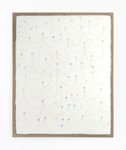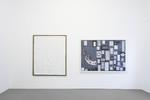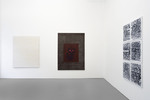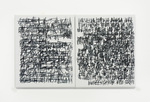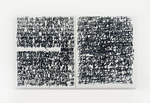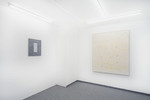Bernshammar, October 26, 2022
Dear Robert,
I was surprised to see your works invaded by cats, tools, scissors, nails, watches, and hooks... These figurative paintings differ from your
earlier works, which are withdrawn, almost shy, with meanings hidden in illegible, seemingly pre-alphabetic, writing. Your new works are extrovert, they want to be seen – and they make me smile,
especially the cat-painting. Now, where do all these things come from? What are they doing with your paintings and maybe more importantly: what are your paintings doing with them?
The answer to the first question is simple. The things come from your father’s garage, in a village in former East Germany. You told me that
he died just before the Corona outbreak and that you have spent a lot of time during the pandemic to deal with his things: everyday objects from the 1970s to the early 1990s. You said that it was
impossible for you just to throw everything away as if it was garbage.
Recently, when my beloved aunt died, I realized that there are so many losses related to her death. When she vanished, I also lost her
irreplaceable view on the world. A view that I sometimes borrowed from her. It helped me to notice important aspects, that I otherwise would have overlooked. Moreover, I lost a connection to the time
that she belonged to. The past has become blurrier.
You said that you and your father were very different. He was an optimistic, practical-minded person, a handy man who enjoyed life a lot. He
also was a collector. The garage was the storage place for his collection. I wonder, if you have not become a collector too.
You said that painting is a way to bring forth and to store the spirit of a thing. It made me think of how Walter Benjamin describes the collector: as someone who uses objects to store lost times. For Benjamin, the collector is a magician; someone who understands the peculiar language of objects: ”One has only to watch a collector handle the objects in his glass case. As he holds them in his hands, he seems to be seeing through them into their distant past.”
I think that you explore objects pretty much the same way as you explore writing. In a way, they are both illegible, but for different reasons. The texts, because their meanings have not yet been established. The objects, because the world that made them meaningful is gone. Now, you bring their spirit back, and you give your father’s collection a safe storage space.
My best,
Jens
P.S. When a thing ends up in a collection, it always becomes brighter, and more distinctive. Maybe because it doesn’t have to be useful any
more. In your paintings, it’s the other way around. The things lose their sharpness and become blurred. In return, something else emerges.
Letter from Jens Soneryd to Robert Schwark, Oysters & Fathers, 29 October–26 November, 2022. Åplus, Berlin.
Å+ Robert Schwark - Oysters Fathers.pd[...]
PDF-Dokument [27.2 MB]


